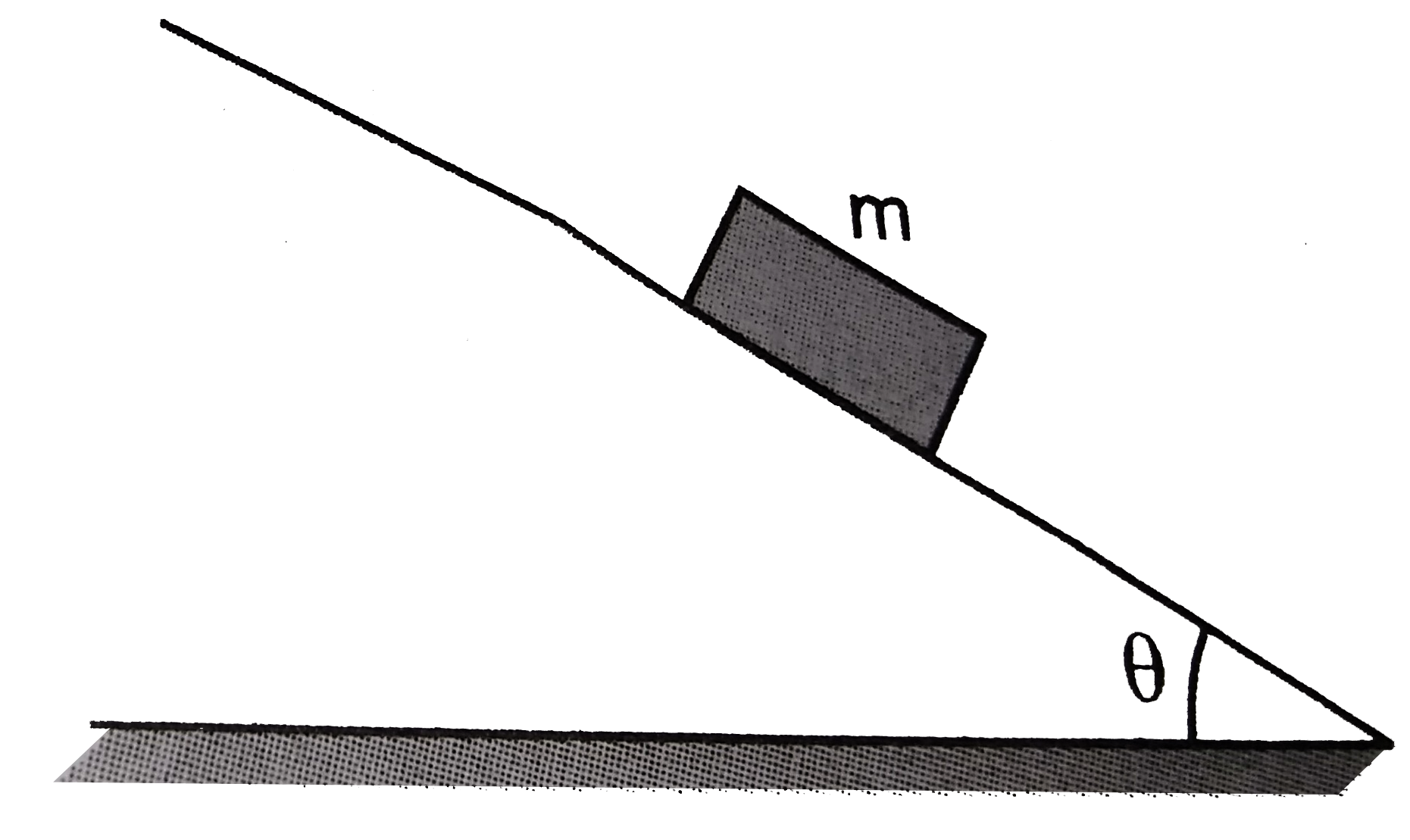A block of mass 5 kg is placed on a rough inclined plane. The inclination of the plane is gradually increased till the block just begins to slide down. The inclination of the plane is than 3 in 5. The coefficient of friction between the block and the plane is (Take, g=10m/s2)
35
34
45
23
The correct Answer is:B
To solve the problem, we need to determine the coefficient of friction (μ) between the block and the inclined plane when the block just begins to slide down. The inclination of the plane is given as 3 in 5, which we can interpret as a right triangle where the height is 3 units and the base is 4 units.
1. Understand the Geometry of the Incline:
- The incline forms a right triangle where the opposite side (height) is 3, and the adjacent side (base) is 4.
- We can find the angle of inclination (θ) using the sine function:
sinθ=oppositehypotenuse=35
2. Calculate the Angle θ:
- From the sine value, we can also find the cosine value:
cosθ=adjacenthypotenuse=45
3. Set Up the Forces Acting on the Block:
- The forces acting on the block include:
- Gravitational force (mg) acting downwards.
- Normal force (N) acting perpendicular to the inclined plane.
- Frictional force (F_f) acting up the incline when the block is about to slide down.
4. Write the Equations for Forces:
- The gravitational force can be resolved into two components:
- Parallel to the incline: Fparallel=mgsinθ
- Perpendicular to the incline: Fperpendicular=mgcosθ
5. Express the Normal Force:
- The normal force (N) is equal to the perpendicular component of the gravitational force:
N=mgcosθ
6. Frictional Force at the Point of Sliding:
- The frictional force at the point of sliding is given by:
Ff=μN=μ(mgcosθ)
7. Set Up the Equation for Equilibrium:
- At the point of sliding, the frictional force equals the component of gravitational force parallel to the incline:
mgsinθ=μ(mgcosθ)
8. Cancel out mg from both sides:
- Since mass (m) and gravitational acceleration (g) are common on both sides, we can simplify:
sinθ=μcosθ
9. Rearranging for μ:
- Rearranging gives:
μ=sinθcosθ=tanθ
10. Calculate the Coefficient of Friction:
- From the triangle, we know:
tanθ=oppositeadjacent=34
- Therefore, the coefficient of friction (μ) is:
μ=34
Final Answer:
The coefficient of friction between the block and the inclined plane is 34.
- The incline forms a right triangle where the opposite side (height) is 3, and the adjacent side (base) is 4.
- We can find the angle of inclination (θ) using the sine function:
sinθ=oppositehypotenuse=35
- From the sine value, we can also find the cosine value:
cosθ=adjacenthypotenuse=45
- The forces acting on the block include:
- Gravitational force (mg) acting downwards.
- Normal force (N) acting perpendicular to the inclined plane.
- Frictional force (F_f) acting up the incline when the block is about to slide down.
- The gravitational force can be resolved into two components:
- Parallel to the incline: Fparallel=mgsinθ
- Perpendicular to the incline: Fperpendicular=mgcosθ
- The normal force (N) is equal to the perpendicular component of the gravitational force:
N=mgcosθ
- The frictional force at the point of sliding is given by:
Ff=μN=μ(mgcosθ)
- At the point of sliding, the frictional force equals the component of gravitational force parallel to the incline:
mgsinθ=μ(mgcosθ)
- Since mass (m) and gravitational acceleration (g) are common on both sides, we can simplify:
sinθ=μcosθ
- Rearranging gives:
μ=sinθcosθ=tanθ
- From the triangle, we know:
tanθ=oppositeadjacent=34
- Therefore, the coefficient of friction (μ) is:
μ=34
The coefficient of friction between the block and the inclined plane is 34.
Similar Questions
Knowledge Check
A block of mass 4kg rests on an an inclined plane. The inclination of the plane is gradually increased. It is found that when the inclination is 3 in 5 (sinθ=35) the block just begins to slide down the plane. The coefficient of friction between the block and the plane is.
A0.4B0.6C0.8D0.75A block is stationary on an inclined plane If the coefficient of friction between the block and the plane is μ then
 .Aμ>tanθBf=mgsinθCf=μmgcosθDthe reaction of the ground on the block is mg cos θ
.Aμ>tanθBf=mgsinθCf=μmgcosθDthe reaction of the ground on the block is mg cos θA block of mass m is placed on a rough inclined plane. When the inclination of the plane is θ , the block just beging to slide down the plane under its own weight. The minimum force applied parallel to the plane, to move the block up the plane, is.
AmgsinθB2mgsinθCmgcosθDmgtanθ
A box of mass 4kg rests upon an inclined plane This inclination is gradually incresed till the box starts sliding down the plane. At this stage slope of the plane is 1 in 3 Find coefficient of friction between the box and the plane What force applied to the box parallel to the plane will just make the box move up the plane ?
View SolutionA block is gently placed at the top of an inclined plane 6.4 m long . Find the time taken by the block to slide down to the bottom of the plane . The plane makes an angle30∘ with the horizontal Coefficient of friction between the block and the plane is 0.2 Take g=10m/s2 .
View SolutionA block of mass 10 kg is placed on an inclined plane when the angle of inclination is 30∘. The block just begins to slide down the plane. The force of static friction is
View SolutionA block of mas m begins to slide down on an inclined plane of inclination θ. The force of friction will be
View SolutionA body weighing 20 kg just slides down a rough inclined plane that rises 5 in 12. The coefficient of friction is
View Solution